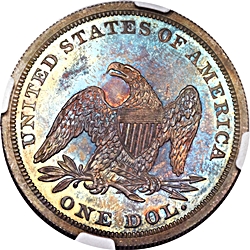 |
1849 
 |
 |
General Comments1849 is a relatively common date in the Liberty Seated dollar series. The mintage is lower than many of the most common dates. It ranks 29th out of 47 dates. However, examples are readily available in all grades below gem BU. Opinions vary on whether the mintage was placed in circulation or exported, but the ready availability vs. the mintage tells us that the former is the case. Most of the mintage must have been placed directly into circulation. Mint state examples are readily available up through MS63. MS64 examples are scarce but can be located with patient searching. Gems are extremely rare. Only 4 examples have received a grade of MS65 or higher from either of the major grading services. The finest known is a MS67 example graded by PCGS, now part of the Legend Collection, owned by Dell Loy Hansen, and pedigreed to the Fairfield Collection. NGC has graded two coins MS66. PCGS has graded one additional example MS65. The two services combined have graded 38 coins MS64. Several of these are almost certainly re-submissions. The enormous jump in value from MS64 to MS64+ or MS65 makes the re-submission of coins grading MS64 possibly very rewarding. A total of 151 coins have been graded at all mint state grade levels. |
| |||||||||||||||||||||
1849 examples can be found with strikes that vary from moderately strong to very sharp. They often display slight softness on the star centrals. The eagle feathers are usually well-defined. High-grade business strikes vary from semi-prooflike to frosty. With a single obverse die used for the entire production run the frosty examples are more common. Examples that are prooflike and/or fully struck can be found with patient searching.
1849 Die Marriages
Only 2 business strike die marriages have been identified. A single obverse die was paired with two different reverse dies, the first transitional from 1848, to strike all business strikes. Neither die was used for proofs. Two proof die marriages paired a single obverse die with two reverse dies, one of which is the used for almost all proofs in the 1840’s. With one exception all proof examples seen have been the OC-P1 die marriage. OC-P2 was only recently discovered by John Dannreuther. Only a single example has been confirmed, but we’ve assumed that there’s probably at least one more out there somewhere. The following table summarizes the known die marriages, with specific comments following.
Click the links below to view the details of each die marriage.
Die Marriage |
Rarity |
Obverse Die |
Reverse Die |
Estimated Survivors |
| OC-1 | R1 | 1 | 1848 A | 1500 |
| OC-2 | R2 | 1 | A | 500 |
| OC-P1 | R7- | P1 | 1840 PA | 10 |
| OC-P2 | R8 | P1 | PA | 2 |
1849 Business Strike Emission Sequence
With no evidence of major wear for obverse 1 the only indication of state is a minor change in the size of the unfinished
area under the chin when comparing early states of OC-1 with later states of OC-1 and OC-2.
Emission Order |
Die Marriage |
Comments |
| 1 | OC-1 | A minor change in the size of the unfinished area under the chin, and the elimination of die lines extending from the denticles right of the date, indicate that OC-1 precedes OC-2. |
| 2 | OC-2 | Die polish reduced the unfinished area under the chin from early OC-1 to OC-2. |
1849 Proof Emission Sequence
We’ve never been able to view OC-P1 and OC-P2 side-by-side other than via photos, so the actual proof emission sequence is unconfirmed.
If we get an opportunity to view both die marriages at some future date we’ll update this information if required.
Emission Order |
Die Marriage |
Comments |
| 1 | OC-P1 | This marriage used the proof reverse that’s common for almost all original proofs issued from 1840 through 1854. |
| 2 | OC-P2 |
1849 Quick Finder Chart
With only one business strike obverse die known identification of the obverse presents no challenge. The reverse, however,
is more difficult. A mid- to high-grade coin will be required to conclusively attribute the reverse die for the two
business strike die marriages.
Die Marriage |
Obv. Die |
Rev. Die |
Right Base |
Keys to Identification |
| OC-1 | 1 | 1848 A | JR of LE | Obverse: Date position is the only necessary marker.
Reverse: Criss-crossing die lines near the top of the shield in recess #1 disappear in late die states. Tiny parallel die lines in the middle of shield recess #4 are visible for all die states. All examples seen have exhibited perfectly aligned dies. |
| OC-2 | 1 | A | JR of LE | Obverse: Date position is the only necessary marker.
Reverse: A defect at the top of vertical shield line 1-3 gives it a pointed appearance. No parallel die lines in shield recess #4. All examples seen have exhibited die rotations of 5-10 degrees counterclockwise. |
| OC-P1 | P1 | 1840 PA | JL of RE | Obverse: Date position the only necessary marker.
Reverse: Defects on A3. |
| OC-P2 | P1 | PA | JL of RE | Obverse: Date position the only necessary marker.
Reverse: Vertical shield line 1-2 extends to horizontal line 4. Vertical line 1-3 extends to line 7. Horizontal shield line 1 extends into the feathers on the left. |
| Photo credits:
Obverse and reverse full photos: NGC PR67, finest known, ex. Phil Kaufman, from the Heritage archives. |
